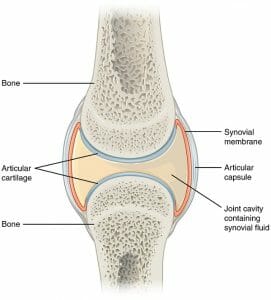Synovial Joint Definition
A synovial joint is a connection between two bones consisting of a cartilage lined cavity filled with fluid, which is known as a diarthrosis joint. Diarthrosis joints are the most flexible type of joint between bones, because the bones are not physically connected and can move more freely in relation to each other. In synarthrosis and amphiarthrosis connections between bones, the bones are directly connected with fibrous tissue or cartilage, limiting their ultimate range of motion. The image below shows several different joints in the human body, each of which are an example of a synovial joint.
Structure of a Synovial Joint
Although the exact structure of a synovial joint may vary depending on the function of the joint and the animal it is in, the general structure of each joint is the same. Extending from the periosteum of the bone, an articular capsulemade of cartilage and other fibers encapsulates the entire joint. Inside the articular capsule, a synovial membrane creates a sac which holds a specialized hydraulic fluid, called synovial fluid. This fluid creates a lubricating cushion between the two bones, allowing them to glide past one another. The ends of the bones are protected in another layer of articular cartilage.
The exact shape of the bone is determined by evolution and the bone’s function in the animal. For instance, ball-and-socket joints have evolved in the human hip to allow humans to have full rotation of their legs. This allows us to run, dance, bend over, climb trees, and even swim.
Function of a Synovial Joint
The main purpose of a synovial joint is to allow to bones to rotate freely about each other. Some synovial joints, like the hip joint mentioned above, are meant to give the greatest flexibility around the joint. Other joints, like the joints found in the ankle, have a slightly more limited range of motion, but provide an enormous cushion for the repeated impacts from running and jumping. A synovial joint may vary slightly in function based on design, but the main purpose of a synovial joint is to provide a range of motion between two or more bones and to cushion the impacts of those bones against each other. Other types of joints provide less range of motion and are susceptible to the cartilage and fibers that connect bones directly breaking down under the stresses of motion.
Although there are many classes and types of synovial joint, the main classifications in function depend on the range of motion conferred by the synovial joint. A uniaxial joint can only move in one direction, such as the elbow. While this is slightly limited in range, it allows the muscles to make extremely powerful levers of the bones connected to these synovial joints. A biaxial joint can move in two directions, which is important for joints in the wrist and ankle. A multiaxial joint can move in a variety of directions, and is seen in the hip and shoulder synovial joints.
Related Biology Terms
- Periosteum – A special layer of tissue that covers bones, creating both new bone tissue and the connections between bones.
- Synovial Cavity – A fluid-filled cavity which exists in every synovial joint and allows the bones to glide smoothly past each other.
- Synarthrosis – A type of joint between bones which is completely immobile, such as those in the skull.
- Amphiarthrosis – Joints which allow a range of motion, but nonetheless keep the bones immobile, like the joints between most vertebrae in a spine.
Quiz
1. One of the benefits of a synovial joint over other types of joints is the ability of the joint to recover after trauma. A synovial joint can undergo an event called dislocation, when the bones become misaligned. However, the bones can usually be forced back into place. Why is this not possible with more fixed forms of joints?
A. Only synovial joints connect bones without firmly connecting their ends
B. More fixed types of joints cannot heal after a tear
C. The fiber used in fibrous joints cannot reform
Synovial Joint


Thanks, sir for providing important material. I am also running the biology website for providing free valuable material to people.
ReplyDeleteThanks for sharing this post. Great information. This blog will really great helpful for student.
ReplyDeleteHome Tutors in Delhi | Home Tuition Services
Everyone participating in anything has to start somewhere, Best local services in kanpur visit us in this industry you will undoubtedly start small and if you put time and effort into your blog you may become successful. Most small time bloggers will use free blog hosting services and this I think is a great platform for inexperienced bloggers and people whom are trying to get a feel of how the Photo background removal services company -visit us whole blog industry and system works
ReplyDeleteWith an independent blog website development company kanpur visit us site you must have paid hosting, knowledge of scripts and plugins etc in order to provide a decent platform for your blog audience whereas here you can put your sole focus onto providing top quality content and all the back Photo Clipping path services company visit us end technical stuff is covered.
The main advantages of having a free blog hosting Thetodaytalk.com visit us service is that if your blog does not become popular or successful you have not lost out. No costs incurred apart from the time you invested into writing the content.